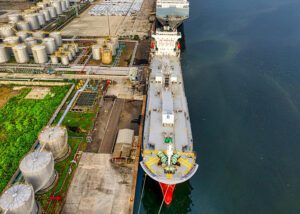Carbon capture is not only effective at reducing the carbon emissions that cause climate change, the technology also has been proven safe through decades of commercial application.
Our ability to use carbon capture appropriately is essential to achieving our goals for controlling climate change while strengthening America’s energy independence. Fortunately, standards that have ensured no harm is done from carbon capture are constantly updated with new technology, meaning the wells being planned now for carbon capture will be the safest in history.
To appreciate the practical possibilities of carbon capture, it helps to understand more about what the technology can do for us, and how natural and human-made protections for capturing and storing carbon dioxide (CO2) make this technology safe.
The 27 carbon capture and storage facilities operating worldwide by 2021 “have the capacity to capture more than 40 MtCO2 (million tons of carbon dioxide) each year,” according to the International Energy Agency. “Some of these facilities have been operating since the 1970s and 1980s.”
The UN’s Intergovernmental Panel on Climate Change (IPCC) says these facilities, and more like them, are essential to achieving emissions reductions we need to counter climate change. Along with increased use of alternative energy sources, “Net zero CO2 energy systems entail: a substantial reduction in overall fossil fuel use, minimal use of unabated fossil fuels, and use of Carbon Capture and Storage in the remaining fossil fuel systems,” the IPCC says.
That’s why the U.S. government has been supporting development of carbon storage sites and technology consistently since 2009.
Geological factors
CO2 is naturally stable underground, and once stored, carbon slowly becomes a permanent feature of the subsoil. Studies have shown CO2 can remain under deep, porous rock formations for thousands of years, and some natural underground pockets have existed for millions of years.
The U.S. Geological Survey (USGS) stipulates carbon storage facilities must be at least 3,000 feet beneath the surface, well below underground drinking water sources, which have a median depth of around 150 feet.
That far down, the temperature and pressure is greater than on the earth’s surface, allowing the carbon to maintain a supercritical state, in which it has the thickness of a gas but the density of a liquid. When CO2 reaches this density, it moves less than a gas, so it is possible to store more of it in a stable manner, according to the Department of Energy.
The type of soil and composition of the layers of earth also make a difference.
Saline formations have the largest CO2 storage potential of any type of terrain, according to the U.S. National Energy Technology Laboratory. Any soil will physically hold captured carbon at the right depth, but saline sand can also change the chemical composition of some of the carbon dioxide, trapping it in either bicarbonate or solid carbonate minerals. Saline soil that is capped by an underground layer of impermeable rock is particularly stable.
In the U.S., sites with all of the ideal properties for carbon storage are found in abundance around the Coastal Plains region, which includes Louisiana and the coastal basins from Texas to Georgia. This region has the potential to store 2 trillion metric tons of carbon dioxide, more than 50 times annual global CO2 emissions, according to USGS.
Regulation and monitoring
All pipelines that carry CO2 are regulated by the U.S. Pipeline and Hazardous Materials Safety Administration (PHMSA), which mandates 24/7 monitoring and sets extensive requirements regarding how pipes are built, inspected, maintained, and protected with emergency plans.
Carbon storage facilities also must comply with EPA Underground Injection Control (UIC) Class VI regulations for CO2 injection wells—with hundreds of additional requirements developed to ensure public health and protect drinking water. Class VI regulations cover areas like site location, construction, inspection, maintenance, operation, monitoring, closure, financing, reporting, and response preparation. Regular inspections and reporting are mandatory.
Before a CO2 injection project gets underway, data from geological testing, fluid samples, temperature, and pressure readings at the site is used to create a detailed computer model of how the stored CO2 will behave, per EPA requirements.
Similar modeling and testing has been used for decades in the oil and gas industry, but with Class VI wells for carbon capture, the level of detail and analysis is far more rigorous. That’s why CO2 pipelines have a far superior safety record compared to pipes carrying gas or oil.
Monitoring of carbon storage includes wells dug specifically to test whether the CO2 begins to move in an unexpected direction, as the U.S. National Energy Technology Laboratory explains. A special deep monitoring well, just above the storage site, ensures no CO2 is leaking toward the surface, and a second well just below the deepest water source ensures the water is free of contamination.
If pressure changes suddenly at any point during the injection, automated controls choke the CO2 injection or stop it completely. If there are any irregularities detected, EPA’s Class VI guidance dictates requirements for a corrective action plan.
After the injection is complete, a separate set of EPA post-injection requirements guide the capping and closing procedures to ensure the underground CO2 plume has stabilized and original pressure is restored. Monitoring continues as the stored carbon becomes permanently fixed.
The process is highly regulated, with redundant protection measures, but the result is a level of safety that allows us to control climate change while maintaining energy independence.














